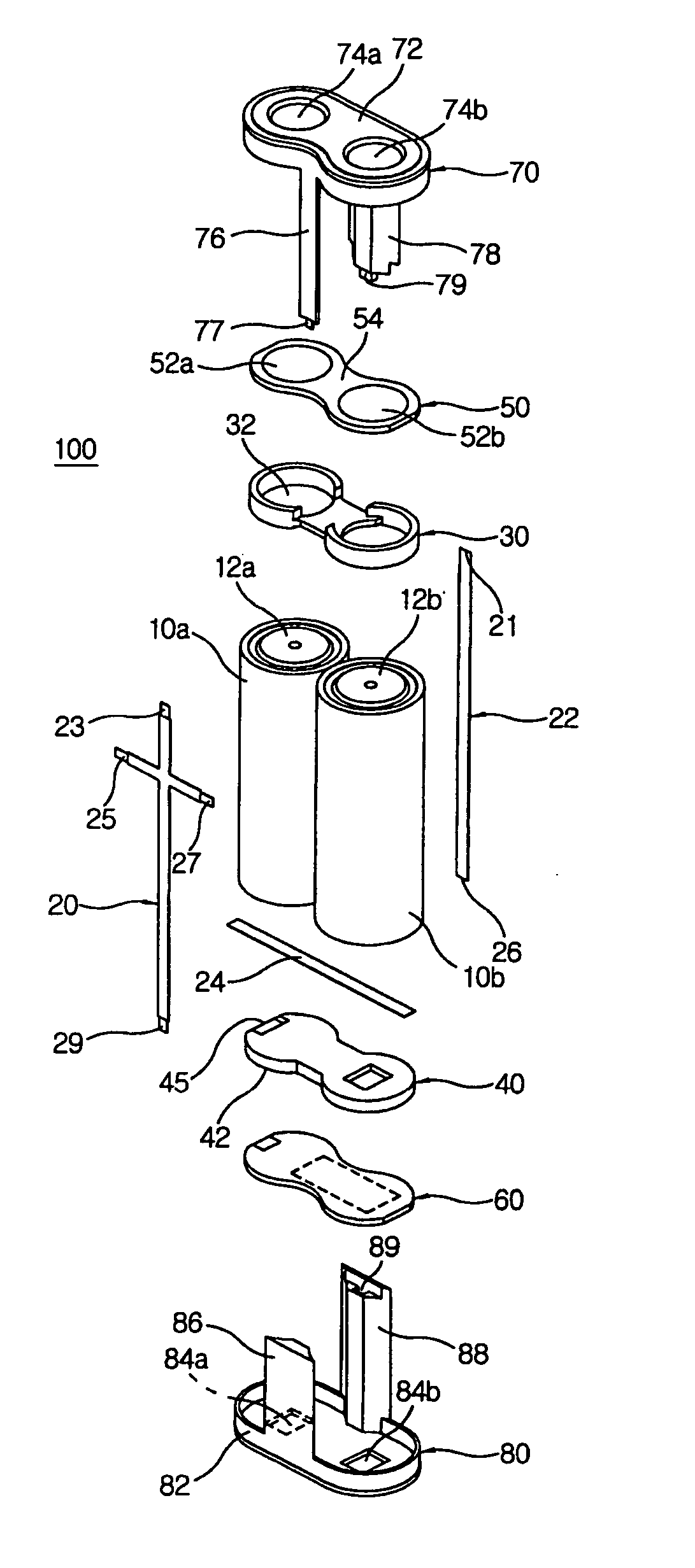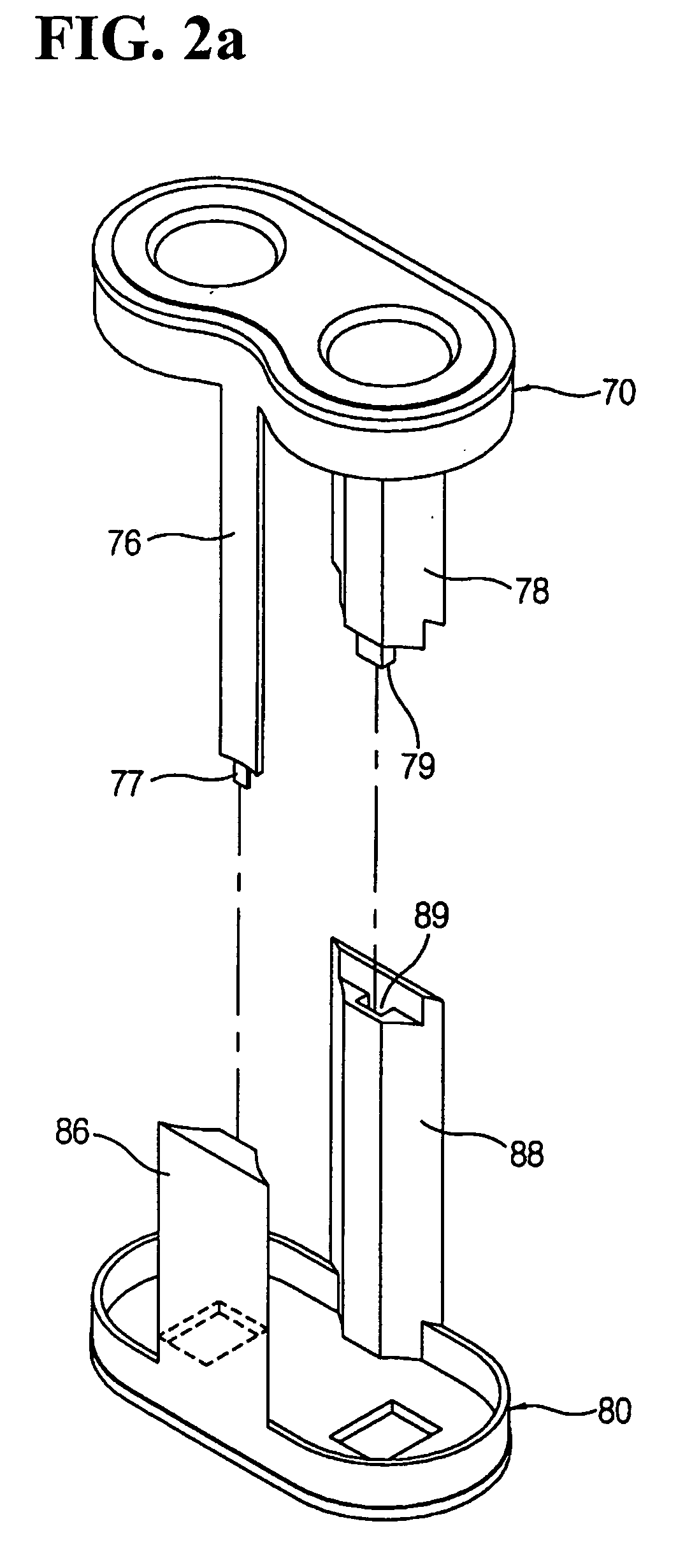Recharbeable battery pack and manufacturing method thereof
- Summary
- Abstract
- Description
- Claims
- Application Information
AI Technical Summary
Benefits of technology
Problems solved by technology
Method used
Image
Examples
first embodiment
[0032] First Embodiment
[0033] FIG. 1 is a perspective view of the battery pack constructed according to the first embodiment for this invention. The battery pack (100) contains two individual batteries (10a, 10b) as well as connecting conductors which electrically connect these batteries. Individual batteries (10a, 10b) include Nickel Cadmium (Ni--CdO) batteries which use Ni(OH).sub.2 as the cathode, Cd as the anode and alkali aqueous solution as electrolytes, Nickel hydrogen (NiMH) batteries which use Ni(OH).sub.2 as the cathode, metal hydride (MH) as the anode and alkali aqueous solution as electrolytes, and Lithium Ion (Li-Ion) batteries which use carbon (C) or graphite as the anode, LiCoO.sub.2 as the cathode and Lithium-Salt organic solvent as electrolytes. However, it is advisable to use Lithium-Ion (Li-Ion) batteries for the individual batteries. Lithium-Ion (Li-Ion) batteries are 40-50% smaller than Nickel Cadmium batteries and 20-30% smaller than Nickel Hydrogen batteries. ...
second embodiment
[0061] Second Embodiment
[0062] FIG. 8 is a break-down perspective view of the battery pack (200) according to the second embodiment.
[0063] Cathode terminals and anode terminals of the individual batteries (210a, 210b) are connected among cathode terminals and among anode terminals respectively, and thereby the individual batteries, electrically connected to each other in a row, form the battery pack (200). These individual batteries are electrically connected by a plate-shaped connecting conductor (212) and a line-shaped sub-conductor (216). The sub-conductor (216) is connected to the connecting conductor (212) in order to have both cathode and anode output terminals formed at both sides of the upper and lower parts of the battery pack (200), whereas the lengthened sub-conductors (216) are each located at the opposite sides of the battery pack (200) so to form different electrodes at each side of the battery pack (200). Between the connecting conductor (212) and the sub-conductor (2...
first circuitry example
[0069] FIG. 11 is a block circuit diagram showing the battery safety unit (350) and the constant voltage circuit (360) which can be included in the battery pack constructed according to the first and second embodiments.
[0070] The battery safety unit (350) includes a voltage detector (352), the first comparator (354), the second comparator (356), and a cut-off switch (358). The battery safety unit serves to eliminate the problem of capacity decline of batteries which occurs when electrical current is continuously supplied from a charger even after an electric charging is completed (380) during the course of recharging the battery pack by applying the current to the battery pack (100, 200) by the external charger (380). For example, when Lithium ion batteries are charged above 4.5V, the electrolytes within the batteries are resolved into gas, which increases the internal pressure of the batteries and causes safety edge to go into action to reduce such pressure. This mechanism can be a...
PUM
| Property | Measurement | Unit |
|---|---|---|
| Time | aaaaa | aaaaa |
| Time | aaaaa | aaaaa |
| Time | aaaaa | aaaaa |
Abstract
Description
Claims
Application Information
 Login to View More
Login to View More - Generate Ideas
- Intellectual Property
- Life Sciences
- Materials
- Tech Scout
- Unparalleled Data Quality
- Higher Quality Content
- 60% Fewer Hallucinations
Browse by: Latest US Patents, China's latest patents, Technical Efficacy Thesaurus, Application Domain, Technology Topic, Popular Technical Reports.
© 2025 PatSnap. All rights reserved.Legal|Privacy policy|Modern Slavery Act Transparency Statement|Sitemap|About US| Contact US: help@patsnap.com



